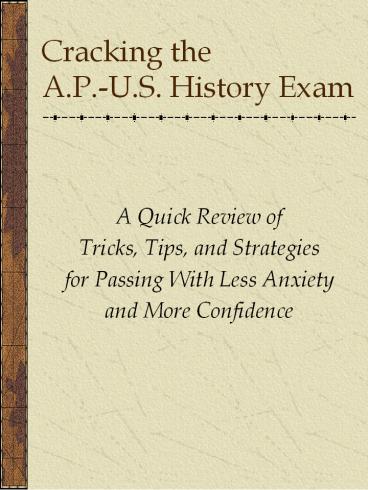Cracking the A.P.-U.S. History Exam - PowerPoint PPT Presentation
1 / 23
Title:
Cracking the A.P.-U.S. History Exam
Description:
Cracking the A.P.-U.S. History Exam A Quick Review of Tricks, Tips, and Strategies for Passing With Less Anxiety and More Confidence Format of the Exam Filling in the ... – PowerPoint PPT presentation
Number of Views:201
Avg rating:3.0/5.0
Title: Cracking the A.P.-U.S. History Exam
1
Cracking theA.P.-U.S. History Exam
- A Quick Review of
- Tricks, Tips, and Strategies
- for Passing With Less Anxiety
- and More Confidence
2
Format of the Exam
- Filling in the forms10 to 15 minutes
- Multiple-choice section
- 55 questions in 55 minutes (40)
- Short Answer
- 4 Questions in 50 minutes (20)
- Break15 minutes
- DBQ
- 55 minutes (15 to plan, 45 to write)
(25) - Long Essay One question (chosen from a pair)
- 35 minutes (5 to plan, 30 to write)
(15) - Time Management is Critical!!!
3
US History Themes
Ideas, Beliefs, and Culture Belief Systems
America in the World America in the World
Environment and Geography Geography
Politics and Power Politics
Identity Identity
Peopling migration Peopling
Work, Exchange, Technology Economics
4
Job OneTo Pass
- Relax and show what you know
- Score roughly 60 correct on the
multiple-choice section - Read carefully and make good choices in the
free-response section
5
National Averages (2013)
- 5 47,098 10.6
- 4 95,413 21.5
- 3 95,660 21.6
- 2 119,665 27.0
- 1 85,054 19.2
- Number of Students 442,890
- 3 or Higher - 53.8
- LCC Average (2013) 83
6
Things You Should Bring to the Exam
- Two 2 pencils and a good eraser
- Two dark blue or black ink pens
- Wristwatch
- Photo ID
7
Things You May NOT Bring to the Exam
- Cell Phones
- Backpacks, bags, purses, etc.
- Books, dictionaries, notebooks etc.
- Laptop computers
- Cameras
- Portable stereos or radios/iPod
- Food
- Clothes with subject related information
8
In the Weeks Before the Exam
- Take practice tests
- Commit 30 to 45 minutes per night to review
- Surf the Internet for history sites
9
In the Final Week Before the Exam
- Maintain your usual routine
- Do a general history review/Focus on big
picture issues and trends - Know the exam directions in advance
10
On Exam Day
- Bring everything you need
- Dress comfortablyin layers (wool blend, cotton,
etc.) Natural Fibers!!! - Relax and have fun!
11
Beating Exam Anxiety
- Take a reality check
- If you are prepared, recognize that fact.
- If not, dont stress. Maximize the benefits of
what you do know. - Relax
- Slow, deep breathing works.
- Move around when it is allowed.
- Eliminate surprises
- Know where and when.
- Know format and question types.
- Know directions and exam length.
12
Cracking theMultiple-Choice Section
- Page 86 of Exam Description
13
Exam Breakdown by Historical Period
- 1 14911607 5
- 2 16071754
- 3 17541800
- 4 18001848
- 5 18441877 45
- 6 18651898
- 7 18901945
- 8 19451980 45
- 9 1980present 5
14
No Military History
- War questions will deal with political or social
implications
15
The Guessing Penalty Process of Elimination
- No Guessing Penalty!
16
Summary
- Pace yourself. Dont spend too much time on a
single question. Keep it steady. - Look for big picture answers.
- Use process of elimination on all but the easiest
questions. - Use common sense and context clues.
17
Short Answer Questions
- Page 98 of Exam Description
- Write in PEN!!!
- 12 minutes per prompt
- Each prompt has 3 parts (a,b,c)
- Identify each part as you write
- Write clearly and neatly
- Do not write outside of specified area
18
Short Answer Questions
19
Section II - Essays
- Write in PEN!!!
- Read the question. Again! (3X)
- Brainstorm
- Plan in an outline
- REMEMBER TO CIRCLE THE ESSAY NUMBER AT THE TOP OF
EACH PAGE!!!!!
20
Section II - Essays
21
Things That MakeANY Essay Better
- Include a clear, identifiable thesis statement.
(Make sure it addresses prompt) - Unless the prompt asks for TWO points, make three
good points. - Keep sentences simple.
- Write clearly and neatly.
- Define terms.
- Tie each piece of evidence to your thesis
- Conclusion should connect to some other
historical period
22
Cracking the DBQ
- READ THE QUESTION. Many do not.
- Address the question FULLY.
- Gather outside information BEFORE reading the
documents. - Read documents with attention to
- source of documents
- inconsistencies within and among documents
- Know what you are going to say BEFORE you start
writing. Use an outline. - Dont necessarily make the obvious choice when
choosing your thesis. There is no correct
answer!
23
Cracking the Standard Essays
- Choose the questions about which you know the
most, not the ones that look easiest. - Brainstorm, write your thesis, and then outline.
- Keep your thesis easily identifiable and roadmap
your response (categories!) - Follow your outline and include examples/proof.
- Write clearly and neatly.
- Tie your main points to your thesis.
- Stay positive! ?































